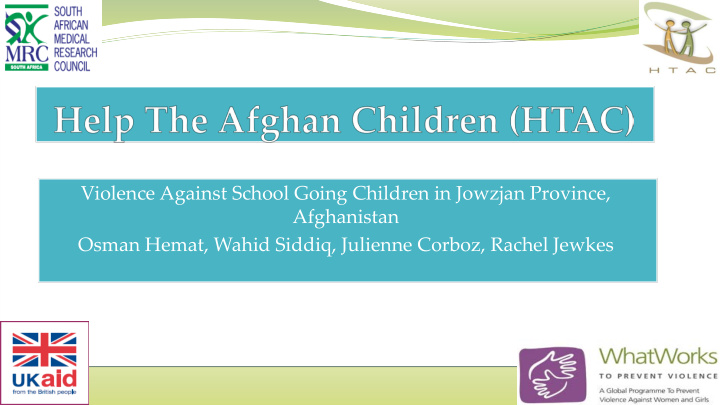



Violence Against School Going Children in Jowzjan Province, Afghanistan Osman Hemat, Wahid Siddiq, Julienne Corboz, Rachel Jewkes
Preventing Violence Against Women and Girls (PVAWG) Jawzjan province (Sheberghan, Khuja Doko, Aqcha and Faizabad Districts) Project Components include: Conflict Resolution and peace building training among community, influential and religious leaders and CSO women representatives Radio Round Table shows and Radio Dramas Peace Education Program in schools
Civil Society Activists and Police in Women Rights Training
Training with community on conflict resolution and peace building
Pho to s o f Pro g ra m Peace Education Training with School Teachers
Peace Education Program with students in schools
Baseline Findings Methodology Study Objective: Study design Students aged 10-19 and teachers in targeted schools. 11 schools (6 girls schools and 5 boys schools), in three districts (Sheberghan, Aqcha and Faiz Abad) Sample size Sample size for students 720 (360 boys and 360 girls) However the baseline slightly under sampled 350 boys and over sampled 420 girls 400 teachers were in sample 85 male teachers and 315 female teachers.
Methodology Questionnaire: Students questionnaire Teachers Questionnaire Data Collection Recruitments Limitation Ethics
Key Findings Prevalence of Corporal Punishment according to Teachers and Students • 35.5% of teacher reported using corporal punishment against students. • Boys: 44.29% experienced corporal punishment in school • Girls: 35.29% reported experience of corporal punishment in school
Factors Associated with Corporal Punishment - Teachers Corporal punishment yes no p value Age 21-30 32.39% 20.23% 0.006 31-40 32.39% 35.8% 41-50 19.01% 28.79% 51-60 13.38% 10.12% 61+ 2.82% 5.06% Has children 78.2% 89.5% 0.006 Years teaching 0-5 16.2% 6.23% 0.003 6-10 23.94% 19.84% 11-20 35.92% 40.86% 20+ 23.94% 33.07% Negative behaviours (mean) 3.97 3.55 0.027
Students Peer Violence Victimization and Perpetration 60.00% 49.70% 50.00% 43.30% 40.00% 31.70% 30.00% Boys 17.60% Girls 20.00% 10.00% 0.00% Victimization Perpetration
Factors associated with peer violence - boys Victimisation Perpetration (+/- Neither only victimisation) n % n % n % p value 1 0.68 3 3.30 8 7.21 0.016 Any abuse of mother 6 4.05 6 8.79 4 3.60 0.39 Father physical fight Any physical violence 9 6.08 18 19.78 31 27.93 0.0412 at home 18 12.16 54 59.34 83 74.77 0.004 Any corporal punishment at school
Factors associated with peer violence – girls Victimisation Perpetration (+/- Neither only victimisation) n % n % n % p value Any abuse of mother 7 3.14 9 7.32 12 16.22 0.028 Father physical fight 7 3.14 22 17.89 32 43.24 0.0002 Any physical violence 8 3.59 39 31.71 37 50.00 <0.0001 at home Any corporal 49 21.97 50 40.65 49 66.22 0.0095 punishment at school 36 16.14 41 33.33 16 21.62 0.0016 Disability
Conclusion and Recommendation Corporal punishment by younger and less experienced teachers is more prevalent in schools. Need to concentrate prevention of corporal punishment with younger and less experienced teachers Peer violence at school, particularly perpetration, is associated with both experiencing and witnessing violence at home, particularly for girls. Disabled girls are at significantly higher risk of peer victimisation than non-disabled girls. School-based interventions aiming to reduce peer violence among children are important but should be complemented with interventions directed at reducing violence at the community and household level.
Thank you
Recommend
More recommend